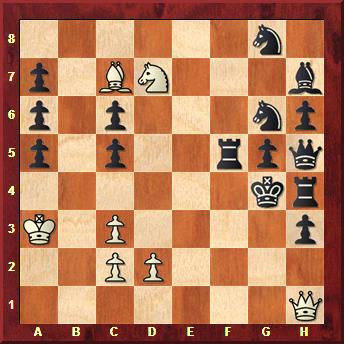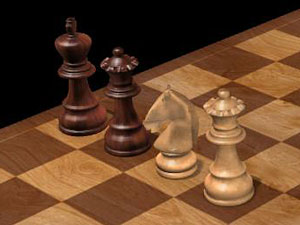Perfect endgame play (3)
By Frederic Friedel
In the first
part of our series we told you how endgame databases (or "tablebases")
worked, using the example of the four-piecer king+queen vs king+rook. It
was the first endgames that was exhaustively calculated, by Ken
Thompson back in the early eighties. He generated every legal position
with the given material and working backwards from mates created a list
in which every position contained information on the distance to mate. His
program used this list to play the queen vs rook ending with absolute perfection
– "as well as god", Ken once quipped. In the subsequent
years Thompson and others worked out all five-piece endings, which we described
in the
second part of our series.
If you have bought one of our
chess programs, they will already play a number of four and five-piece
endings (e.g. Q vs R or R+P vs R) perfectly. With the Endgame
Turbo (see below), which is delivered on four CDs, the engines will
play all important five and six-piece endings perfectly. They will in fact
use the endgame knowledge in the search, so that games against the computer
these days usually end in mate announcements in 20 or more moves!
Since a majority of our readers will have a chess program with access to
five-piece endings we have decided to give you a weekend puzzle that requires
a little more than firing up the engine and pressing a key. It is a position
that Thompson dug up in 1986, when he was fooling around with his first
five-piece endings.

Ken discovered that with the above material on the board there is only
one square on which the white king can be placed so that the position is
winning by force. Really, only one square – put the white king on
any other and Black is able to force a draw. You are invited to solve this
using your five-piece tablebases. But do not post the solution in our
discussion section below, if and when you have found it.
Longest direct mate problem
Endgame databases can, with the given material on the board, instantly
tell you if a position is won, lost or drawn, and how many moves it is to
mate. But the mate they announce – often in dozens or even scores
of moves – is not like that of a chess problem: it denotes the number
of moves the attacking side will require against the best possible defence
by the defender. But there are many alternatives, many different paths to
reach the same goal. In chess problems of the "Mate in three"
variety there needs to be one single move at each stage for the attacker
to reach the goal. If any deviation is possible the alternative move is
called a "cook" of a "dual". It generally spoils the
problem.
So what is the longest mate problem, one in which every single move of
the attacker is forced and where there is no alternative for each move,
no variation that would not lead to the goal of the problem being met in
a (even slightly) different way. In 1976 the longest whistle-clean direct
mate problem was published:

In the above position it is White to play and mate in 203 moves,
would believe it? We will not mention the name of the composer yet, to encourage
you to think about the problem for a while, instead of searching the Internet
for the pre-digested solution (damn you Google!). Make copious use of your
computer, and run the strongest engines you have. Here in fact is the FEN
description to make it easier for you:
6n1/p1BN3b/p1p3np/p1p2rpq/6kr/K1P4p/2PP4/7Q w - - 0 1
It is possible to work out the general idea of the problem with a regular
chess engine, but you will have to also think about how Black can delay
the inevitable for as long as possible – 203 moves, to be exact. Feel
free to discuss it in the feedback section below. We will show you
the solution during the coming week, with expert annotations provided by
the supreme problemist John Nunn.
Incidentally there have been attempts to construct longer dual-free direct
mates since the above position was published, back in 1976. But none to
our knowlege was as clean an free of any possible deviation than the one
given above.
Endgame databases for notebook computers
 In
the years after the pioneer work with four-piece endings Ken Thompson and
others worked out all five-piece endgames, which have between 212 and 335
million positions each. And then came the six-piece endings, which required
truly massive computing power to calculate – and plenty of hard disk
space to store. Russian programmer Eugene
Nalimov created a new format that required eight times less space than
the previous versions. And in 2013 Ronald de Man developed the "Syzygy
Bases" that were in turn seven times smaller than the Nalimov tablebases.
For the first time it was possible (or practical) to provide users six-men
tablebases on DVDs.
In
the years after the pioneer work with four-piece endings Ken Thompson and
others worked out all five-piece endgames, which have between 212 and 335
million positions each. And then came the six-piece endings, which required
truly massive computing power to calculate – and plenty of hard disk
space to store. Russian programmer Eugene
Nalimov created a new format that required eight times less space than
the previous versions. And in 2013 Ronald de Man developed the "Syzygy
Bases" that were in turn seven times smaller than the Nalimov tablebases.
For the first time it was possible (or practical) to provide users six-men
tablebases on DVDs.
If you buy one of our
chess programs, they will already play a number of four and five-piece
endings (e.g. Q vs R or R+P vs R) perfectly. With Endgame
Turbo the programs will play all important five and six-piece endings
perfectly. They will in fact use the endgame knowledge in the search, so
that positions with many more than six pieces that can be traded down to
advantageous six or five-piece endings will be handled perfectly as well.
Endgame Turbo 4 contains all five and 27 of the most important six-piece
endgames in the Syzygy format, which can be used with top engines like Komodo
8 or Houdini
4. Endgame Turbo 4 consists of four DVDs with the following endgames:
You
can order Endgame Turbo 4 in the ChessBase shop here.
Price: €59.90 – €50.34 without VAT (for customers outside the
EU) and $54.03 (without VAT).
Expect to read more about five and six-piece endgame
databases in a future report.




















 In
the years after the pioneer work with four-piece endings Ken Thompson and
others worked out all five-piece endgames, which have between 212 and 335
million positions each. And then came the six-piece endings, which required
truly massive computing power to calculate – and plenty of hard disk
space to store. Russian programmer
In
the years after the pioneer work with four-piece endings Ken Thompson and
others worked out all five-piece endgames, which have between 212 and 335
million positions each. And then came the six-piece endings, which required
truly massive computing power to calculate – and plenty of hard disk
space to store. Russian programmer 








